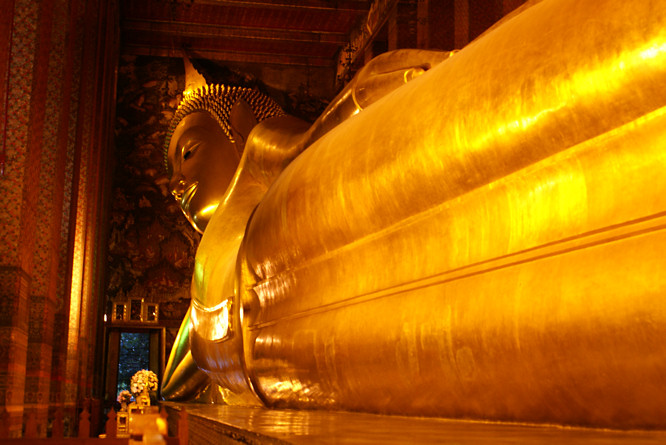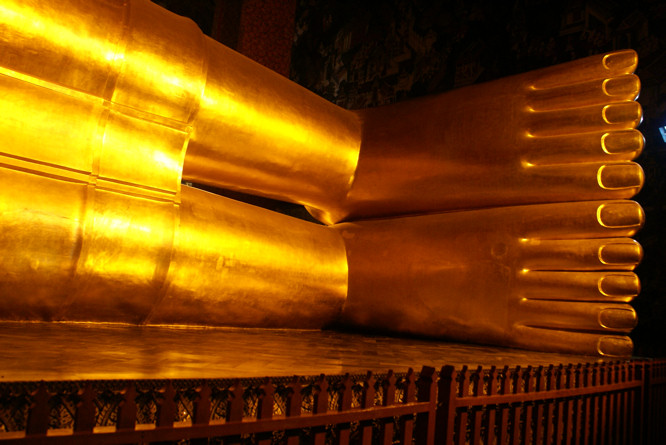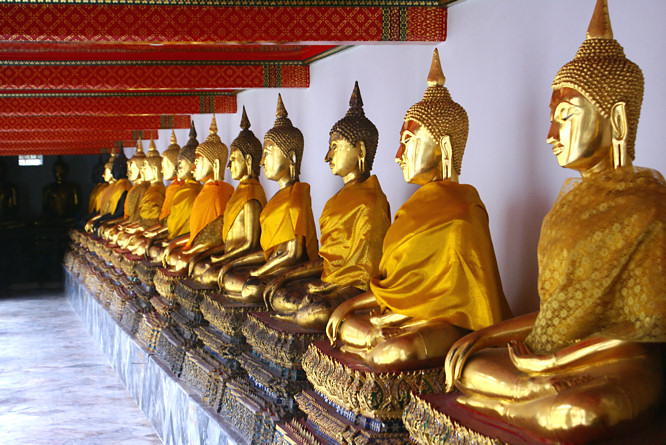Bangkok Wat Pho Temple of the Reclining Buddha
The oldest and largest Buddhist temple in Bangkok is the Temple of the Reclining Buddha. It's full name is Wat Phra Chetuphon Vimolmangklararm Rajwara Mahaviharn, often shortened as Wat Chetuphon but more popularly known simply as Wat Pho. 'Wat' means temple. It is a word you will see often around Bangkok.

WAT Pho is located on Sanam Chai road and Maharaj road next to the Grand Palace. It is open daily between 08:00 - 17:00 hrs, with an admission fee of 50 baht. Tourists must be in correctly dressed, no shorts, no exposed shoulders, no above the knee skirts or dresses. It is polite to take off your shoes and put them on the shelf before entering every religious building. Woman are prohibited from all areas set aside for monks to perform their rites.
This temple is nearly as impressive as the Grand Palace. I was amazed at how huge the reclining Buddha. He is massive. There is a one way pedestrian system around the long hall of the gold reclining Buddha. You enter by his head and work your way down to his feet then you walk to wards the exit along his back and up by his head.

Tripods are not allowed. It is quite dark inside the temple of the reclining Buddha. To avoid camera shake place you camera on a flat surface and use the timer facility to take the photo. To give it perspective try to have some one standing near the Buddha to show how immense the statue is. The soles of the statue's feet are inlaid with mother-of-pearl . This statue is 46 metres long, with the dimensions at the face of 15 metres high and at each foot of 3 metres high and 5 metres long. The Bangkok reclining Buddha is one of the more memorable sites on our trip.
You will find the temple complex to the south of the Grand Palace. The grand entrance is in a road called Thai Wang. There is an entrance fee but it is not expensive. Thai Wang road is in the north of the Wat Pho Temple and monestry, Sanam Chai road is in the east, Setthakan road in the south and Maharat road in the west. Separated by a tall white wall on Chetuphon road, the monastery has two main quarters : the sacred chapel section called Buddhavas and the residential area, the monk's living section called Sangghavas.
It is more than just a temple. It is famous as the birthplace of Thai message. It offers courses in the subject and is a centre of education for traditional Thai medicine. The Thai message school offers hour long sessions in massage, herbal massage and foot massage.
Within the western courtyard of Wat Pho are a number of chedi, or Buddhist spires. The four big ones are called the Phra Maha Chedi. They are each 41 meters tall, and arranged three in a row One special chedi is at the central back area. It contains the sacred Buddha image from the former Royal destroyed ancient Palace of Ayutthaya. The chedi to the north was built by King Rama III to enshrine the ashes of King Rama II.

The Wat Pho Monastery Main Chapel Phra Uposatha
The main chapel Phra Uposatha contains a seated Buddha in the posture of conoentration on a three tiered pedestal. Some ashes of King Rama I are kept under the pedestal. For Buddhists, the main chapel is the heart of the monastery, as without a main chapel, it would be a monk centre and not a monastery. The main chapel was constructed in the reign of King Rama I in the Ayudhya style. It was then reconstructed and enlarged during the reign of King Rama III. All sheltered windows and doors are made of hard wood with crown-like spires and colour-glazed tiles
There are 4 pagodas at the corners of outer-side of the main chapel yard. This kind of pagoda is specially termed 'Phra Agghiya chedi'. A chedi is used to house ashes of the dead. They are brick built and then covered in plaster and decorated. The main Chapel yard is lined with a double cloisters and lines of gold seated Buddha. Some of the Seated Buddha are dressed. In the East Vihara building there is a standing Buddha statue that is a 10 metres high.
Chinese rock giant Gate Guardians
A number of the temple gates have covers. These are called sheltered gates. They come in handy during the rainy season. Some of the gates have gate guardians called Chinese rock giants - Lan Than Nai Tvarapala. They represents Chinese nobleman warriors in Chinese opera style clothes looking down at visitors with a fierce-face. They hold large vicious looking weapons in their hands. Some of the huge gate guardian statues are wearing what looks like top hats. They are called Farang Guards. They look peculiar as they are wearing a mixture of Thai and Western attire. They are said to represent Marco Polo, the first European visiting and introducing European traditions to China.
Travel books

